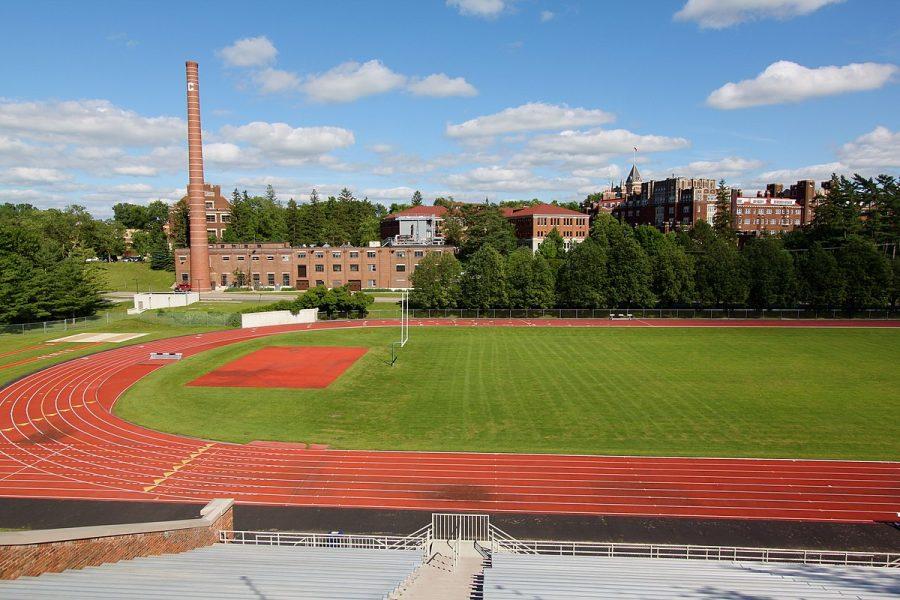After months of quarantine and social distancing, the time has finally come. Laird Stadium’s gridiron is painted, Bell Field’s soccer pitch is drawn to perfection and the lane lines at Thorpe Pool are stretched in place. On Monday September 28th, athletic teams across campus will begin to navigate the uncharted waters of a COVID-19 regulated practice schedule.
For Head Football Coach Tom Journell, the pandemic has introduced an unprecedented set of challenges. In his 33 years of coaching experience, he has never had to be so flexible.
“The biggest hurdle has been understanding the ground rules for practice and keeping up with the changes, because one day the NCAA will lay out its guidelines, followed by the conference, and then the school. We’re just trying to stay ahead of the posse here,” said Journell, who spent the summer in Northfield hosting virtual recruiting visits for prospective players.
“Going into this summer, the plan was not to have a plan, because we knew things were always subject to change,” he laughed. In spite of ever-evolving health guidelines, Journell continues to maintain his signature “labrador-like-enthusiasm” in preparing for next season, whenever that may occur. In a normal world, his team would be preparing for a matchup tomorrow against Concordia College Moorhead, the fourth game on their schedule.
In order to make practices as safe as possible, the Athletic Department adopted health guidelines to ensure a certain level of social distancing is observed among athletes. To prevent close contact across large groups, teams will practice in predetermined pods. The football team, for example, will practice in separate pods of no more than 14 athletes, while the women’s volleyball will split into two pods of eight. Upon arrival to practice, athletes are required to display their personal information from SHAC’s COVID-19 online portal, including evidence of their most recent negative test result and a survey indicating they display no symptoms. On the field, balls will be periodically sanitized and coaches will use electronic whistles to prevent spit particles from dispersing into the air. Guidelines such as these constitute Phase I, and are subject to change depending on future testing data.
Under the pod-based practice structure, the typical nature of football practice will be acutely disrupted. For a sport which requires 22 players on the field at once, a team practicing in pods may find itself severely limited in terms of what it can productively accomplish on the field. With this in mind, Journell and his coaching staff made some tough decisions when they strategically formed their pods and began designing practice. Ultimately, they felt the need to eliminate competition between the offense and defense, periods which normally occupy a significant portion of any normal practice. “As a staff, we had to sit down and ask ‘What can we do?’ In these pods, what’s best for the offense may not work for the defense, and as coaches we had to address that in formulating our practice plans.”
Rather than focusing on live competition between the offense and defense, Journell and his staff will focus on improving individual technique and re-teaching various schemes. He believes that if this practice is taken seriously, the increased amount of attention allotted to these aspects of the game could bolster the long-term development of his team. “During a normal pre-season, there’s a lot of pressure to get ready for that first game. Now that we won’t be playing for a while, we can slow down the pace and really make sure our young guys are getting enough attention and developing properly as players.”
Receiving some attention will be a breath of fresh air for many first-year athletes, who have been unable to formally meet with their coaches and teammates in-person, making it difficult for them to feel included in the framework of their teams. In a typical season, fall athletes arrive on campus in mid-August, nearly a month ahead of when the general student body arrives in September. Generally referred to as “fall camp,” this is a time for first year athletes to familiarize themselves with campus and learn from the upperclassmen about how to carry themselves as student-athletes. In a COVID-19 world, first-year students are suddenly dropped on campus with limited opportunities to meet their new teammates and learn from the role models traditionally set by veteran team leaders. Team meetings on zoom are great, but they don’t quite allow for a genuine sense of connection.
Jancyn Appel, a Junior on the women’s volleyball team, echoed this concern. “We’ve been trying to find ways for our freshmen to meet other students and athletes, but it’s so hard. Most of them haven’t really branched outside of their new student week groups,” she said. Some teams have utilized a “big brother” or “big sister” program, connecting first year athletes to an upperclassmen to ensure they have a place to turn for advice and guidance.
Henry Detmer, a first-year member of the football team, believes the program is working well so far. “I’ve enjoyed learning certain things from my big brother, but I think practice will help everyone meet and bond so much better. In my experience, that’s where teams really come together.”
Even with the obstacles which come from such an unprecedented fall, athletes and coaches across campus are eager to make the most of an opportunity to practice again. Looking ahead, most fall athletic teams plan to resume competition in early March, when they will play an abbreviated schedule. In the meantime, teams like the football and volleyball team will enjoy the chance to come together once again and focus on building their chemistry. Detmer adequately summarized a sentiment shared by all athletes back on campus: “I’m just excited to be here with my teammates. Games or no games, I’d rather be here than back at home.”












